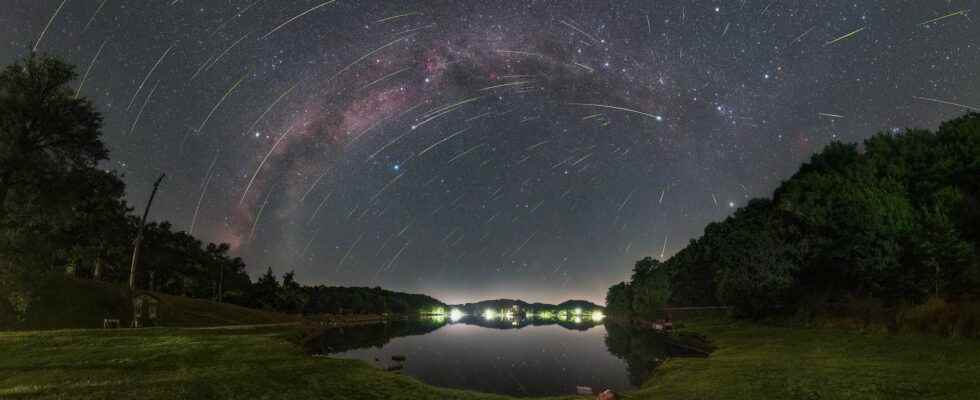You may also be interested
[EN VIDÉO] Discover the meteor shower of the Perseids The shower of shooting stars from the constellation of Perseus: the Perseids. These meteors are particularly spectacular, especially in summer!
Everyone has already heard of the Perseids, one of the most active meteor showers of the year, making “rain” each summer in our sky, up to 100 meteors per hour, in the best conditions. In other words, a beautiful shower of shooting starswonderful spectacle of nature which invites you to stretch out in the (dry) grass, with family or friends, in the company of crickets, and to daydream about the eyes plunged into the sky scintillating with stars, on the lookout for these furtive and luminous cometary debris. A celestial spectacle rich in interest which, we will never stress enough, requires finding a remote and peaceful site, in the countryside, far from the noise and the fury of the light pollution big cities, to take full advantage of them.
Yes, but… this year, there is a problem: the Full moon which will shine from evening to morning during the night of peak activity, August 12-13, significantly reducing the possibility of seeing a large amount ofshooting Stars. Thus, instead of the 50 to 60 (and sometimes more than 100, depending on the year) micrometeorites visible per hour in the second part of the night, it will be necessary to be satisfied with the brightest, reduced to a maximum of ten per hour. The day before and the day after the expected peak, the conditions will not be better, because the Moon almost full will also remain a problem for detecting them. And since it is not possible to turn it off or to shelter from it, it will therefore be necessary to deal with… Or else, choose another night, when the Moon is “skinny” (last crescent).
The best time to see the Perseids
All is not lost therefore, because the Perseid meteoritic swarm extends from July 17 until August 22, which offers several moonless nights or else, with a more discreet presence (in crescent or last quarter) . There will be many opportunities to observe them in large numbers after the August 12-13 peak.
Like every year, whatever night you choose to observe (and count) the Perseids — before, after or on the date of the peak of activity — you should wait until sunrise. constellation of Perseus — which gave its name to the meteorite swarm — and its ascent in the sky, because it is within it that the radiant is located. This takes place in the second part of the night, to see as much as possible. This is when the Earth enters the densest region of the debris field left by the passages of comet 109P/Swift-Tuttle (its orbital period is 133 years old).
Finally, “last but not least”note that this summer, there are not only shooting stars to see: indeed, several planets pass one after the other in the sky to form a beautiful alignment on theecliptic at thedawn. The first of these to rise is the marvelous Saturnfrom 10 p.m., followed by Jupiterunmissable by its brilliance, from midnight. March the red arrives quietly around 1:30 a.m. and finally, the sparkling Venus arises in the gleams of Dawn (“with rosy fingers”Homer), around 5:30 a.m. Also not to be missed, using a pair of binoculars, the giant comet C/2017 K2 PanStarrs, currently visible in Scorpius early in the night!
Very good observation to all.
NB: To withstand the coolest hours of the night, bring warm clothes.
The Perseids meteor shower in 2016
Article of Xavier Demeersmann published on August 12, 2016
On the night of August 11 to 12, the activity of the Perseid meteoritic swarm will be at its peak: around 200 shooting stars per hour could be visible. Double the other years.
One week after the 26enight of stars, the sky offers us a new spectacle: a shower of shooting stars. Remember that this recurring phenomenon has nothing to do with shooting stars… These are micrometeorites, most of them as big as a grain of sand or a grain of rice, and which disintegrate in the high atmosphere. A few, the brightest de facto, can be the size of a fist. Those of August belong to the meteorite swarm of the Perseids, because their radiant is located in the direction of the constellation of Perseus. It’s not the only swarm of the year, but since it occurs on mild summer nights, during holidays, and its rate of visible meteors per hour often exceeds 100 during its peaks of activity, he became very famous.
This year, the maximum is expected on the night of August 11 to 12. The specialists are enthusiastic because, at the height of the event, in the second part of the night, these small grains left in the wake of comet Swift-Tuttle should be twice as numerous as usual to penetrate the atmosphere at a speed average of 59 km/s. The forecast is for 200 meteors per hour.
Why this upsurge? Because under the gravitational influence of the planets, especially that of Jupiterthe dust currents of 1079, 1479 and 1862 left by the passages of the comet in the internal Solar System, approached our Planet.
Also, if so, the show promises to be twice as wonderful. Provided of course that the weather report is favorable and that the light pollution be minimal. As for the Moon (in conjunction with Saturn and Mars), embarrassing for its brightnessit will disappear below the horizon after midnight, i.e. when Perseus takes to the skies… to be able to take in as much of the sky as possible.
Interested in what you just read?
